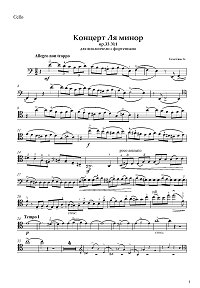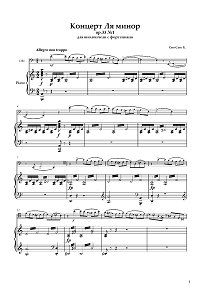Saint-Saens – Concert Op.33 N1 for cello and piano
Saint-Saens – Concert Op.33 N1 for cello and piano. You can download the PDF sheet music Saint-Saens – Concert a-moll Op.33 N1 for cello and piano on this page. Camille Saint-Saëns composed his Cello Concerto No. 1 in A minor, Op. 33 in 1872, when the composer was 37 years old. He wrote this work for the Belgian cellist, viola de gamba player and instrument maker Auguste Tolbecque. Tolbecque was part of a distinguished family of musicians closely associated with the Société des Concerts du Conservatoire, France’s leading concert society. The concerto was first performed on January 19, 1873 at the Paris conservatoire concert with Tolbecque as soloist. This was considered a mark of Saint-Saëns' growing acceptance by the French musical establishment.
To download PDF, click the "Download PDF" button below the appropriate sheet music image.
To view the first page of Saint-Saens – Concert a-moll Op.33 N1 for cello and piano click the music sheet image.
|
| PDF format sheet music |
|
|
|
Cello part: 11 pages. 489 K
|
Piano part: 32 pages. 912 K
|
 |
 |
|
|
| Download PDF (14.99
€) |
Download PDF (14.99
€) |
|
Saint-Saëns broke with convention in writing the concerto. Instead of using the normal three-movement concerto form, he structured the piece in one continuous movement. This single movement contains three distinct sections. Those sections, tightly-structured, share interrelated ideas. Saint-Saëns' contact with Franz Liszt while serving as organist at the Église de la Madeleine may have led him to use cyclic form in his orchestral works.
The work can be split into three different sections as follows:
- Allegro non troppo
- Allegretto con moto
- Tempo primo
Saint-Saëns very often uses the solo cello here as a declamatory instrument. This keeps the soloist in the dramatic and musical foreground, the orchestra offering a shimmering backdrop. The music is tremendously demanding for soloists, especially in the fast third section. This difficulty has not stopped the concerto from becoming a favourite of the great virtuoso cellists.
Yet a third factor in the work might well have been the incipient recovery of Paris after the Franco-Prussian war and the Commune. In February 1871 the new Société Nationale de Musique, with Saint-Saëns as one of its founder members, had promoted its first concert under the banner 'Ars gallica', and the impetus was thereby given to young French composers to outdo the Germans in every way possible. It was partly pressure from the Société that pushed the staid Concerts du Conservatoire into accepting the premiere of Saint-Saëns's first concerto on 19 January 1873, but more the request from the established cellist Auguste Tolbecque—without which, the conductor kindly informed the composer, the work would not have had a hope.
The first cello concerto has always been one of Saint-Saëns's most popular pieces, Casals choosing it for his London debut in 1905. Tunes abound, but not in any disorderly way: the main themes of the outer movements move upwards, the second themes downwards; if, that is, the opening cello motif can be called a 'theme'—the composer's biographer Brian Rees refers to it as 'an artefact rather than a melodious outburst'. The central minuet is a movement of pure delight and, in those uncertain times, no doubt reassured Parisian audiences that French culture had after all survived, one critic remarking that here the composer was making up for a recent 'divergence from classicism'. The return of earlier material in the third movement may owe something to Saint-Saëns's study of the cyclic patterns found in Liszt, to whom he remained indebted all his life.
|
|